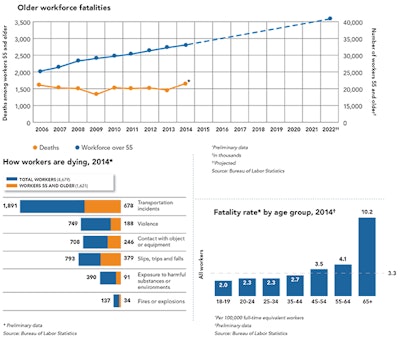
Many factors have caused older workers to remain on the job longer and the trend is only expected to increase. This change in demographics has several different effects on workplace safety trends.
About one-quarter of all workers are expected to be 55 or older by 2022, according to Mitra Toossi, an economist with the Bureau of Labor Statistics’ Office of Occupational Statistics and Employment Projections.
RELATED > Construction deaths up 10% in preliminary 2014 report
Those born between 1946 and 1964 have been staying at their jobs longer, while members of previous generations typically stopped working at 55. Part of the demographic change is owing to a change in employee benefits. Previously, those who worked 30 years would qualify for a pension or defined retirement sum, while now workers have 401(k) plans that are susceptible to market changes.
Economic factors, a desire to retain health insurance through their jobs, and the higher age for Social Security eligibility all play a part, but some workers simply enjoy their jobs and want to keep working.
“People live longer lives,” Toossi said. “They live healthier lives, so those who have jobs just cling onto the job and they don’t want to give it up.”
One of the good things that come from having older employees in the workforce is that they are less likely to be injured on the job than any other age group, with one important exception: Those 65 and older have a higher rate of slips, trips and falls. At 49.5 injuries from slips, trips, or falls per 10,000 workers, the rate of such injuries among workers 65 and older is double the rate of employees younger than 45.
And as you’d expect, when injuries do happen, there’s a significant difference in recuperation time between younger and older workers. While it generally takes 16- to 19-year-old workers only four days to recover from an injury, workers 65 and older normally require a total of 17 days away from work.
While it’s natural for people’s bodies to decline as they age, Bill Spiers, a risk control services manager with consulting firm Lockton, says the aging of the workforce will translate to higher workers’ compensation costs.
“The wave is coming,” Spiers said. “As those people stay, it’s my opinion that the cost of those injuries is going to be higher.”
Older workers also have the highest risk of work-related death. In 2008, 580 workers 65 and older died on the job for reasons other than natural causes; in 2014, the number was 656. Between 2013 and 2014 alone, the number of work-related fatalities in the 65-and-older age group rose 17 percent.
Safety and Health Magazine cautions that the Bureau of Labor Statistics’ figures for 2014 are preliminary; but, if the 17 percent increase holds true, researchers will be trying to determine why the pronounced increase in work-related fatalities is affecting only the 65 and older demographic.
Meanwhile, the National Institute for Occupational Safety and Health (NIOSH) has begun researching “aging-friendly” workplaces.
Ken Kolosh, manager of statistics for the National Safety Council, points out that when safety improvements are made to protect older workers, workers of all ages typically benefit.
NIOSH health communication fellow Juliann Scholl says U.S. employers should try to instill an appreciation of safety practices in their young workers from day one.
“The sooner you can instill these habits and practices, the longer it stays with them as they move into an older age,” Scholl said.













